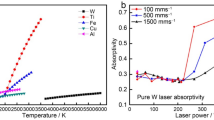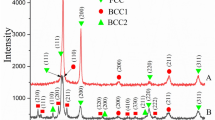Abstract
The addition of 1wt% titanium to gold was found to substantially harden the precious metal and enhance its wear resistance, which makes it attractive for jewellery applications. The enhanced hardening is due to the formation of fine AU4Ti precipitates under the appropriate thermo-mechanical treatments. It has been shown that another hardening mechanism can be induced in wire having a diameter of less than 100μm, which is stable to heating in air up to 200°C. These observations are consistent with the formation of a network of titanium oxide inclusions up to 100μm below the free surface, which has been reported elsewhere. New results have indicated that thin foil of Au-1Ti, which has been subjected to similar thermo-mechanical processing, exhibits similar properties to those of fine wire of this material. Potential uses for the fine wire and foil are described.
Similar content being viewed by others
References
A.M. Tasker,Aurum, 1988,34, 62
J.L. Murray in ‘Binary Alloys and Phase Diagrams’, Volume 1, ed. T.B. Massalskiet al, ASM, Metals Park, USA, 1986, p. 324
R. Wagner and R. Kampmann in ‘Phase Transformations in Materials’, Volume 5, ed. R.W. Cahnet al, VCH, Weinheim, Germany, 1991, p. 213
D. Heger, K. Jenkner, P. Klimanek, D. Bergner, and Ch. J. Raub,Mat.noiss., u. Werkstoffiech, 1995,26, 507
G. Humpston and D.M. Jacobson,Gold Bull., 1992,25, 132
G. Humpston and D.M. Jacobson,Gold Technology, 1992,6, 5
G.L. Selman, J.G. Day and A.A. Bourne,Platinum Metals Rev., 1974,18, 46
A.E. Heywood and R.A. Benedek,Platinum Metals Rev., 1982,26, 98
R.B. McGrath and G.C. Badcock,Platinum Metals Rev., 1987,31, 8
R. H. Perry and D.W. Green, ‘Perry’s Chemical Engineer’s Handbook’, 6th Edition, McGraw-Hill, New York, USA, 1984
S. Tomiyama and Y. Fukui,Gold Bull, 1982,15, 43
V. McGinty,Electronic Packaging and Production, October 1995, 42
Author information
Authors and Affiliations
Additional information
Dr Jacobson manages The Materials Processing Group at the Hirst Division of GMMT Ltd, and possesses wide experience in metal joining and bonding methods, having graduated as a physicist and obtained his doctorate in Materials Science. He has worked in the joining of gold for ten years and made many original contributions to the field.
Dr Harrison obtained his doctorate from Oxford in Solid State Chemistry and carried out post-doctoral research at Cornell and Cambridge Universities on materials undergoing metal-insulator transitions. He has spent the last decade investigating the synthesis and properties of the new high temperature superconducting ceramics. Recent interests include the development of electronics packaging materials, metallizations and solders for microwave devices.
Dr Sangha is an electrical engineer whose doctorate is in Materials Science . He has applied his knowledge to the assessment of gallium arsenide semiconductor systems and the development of low melting point brazes for joining a wide range of aluminium engineering alloys before investigating the gold systems described herein.
Rights and permissions
About this article
Cite this article
Jacobson, D.M., Harrison, M.R. & Sangha, S.P.S. Stable strengthening of 990-gold. Gold Bull 29, 95–100 (1996). https://doi.org/10.1007/BF03214742
Issue Date:
DOI: https://doi.org/10.1007/BF03214742




